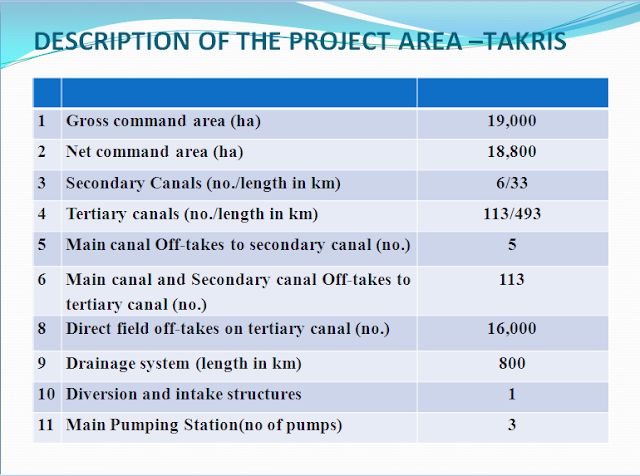APPLICATION OF MASSCOTE APPROACH ON MODERNIZATION OF IRRIGATION SYSTEM - A CASE STUDY FOR TANJUNG KARANG
RICE IRRIGATION SCHEME, MALAYSIA
RICE IRRIGATION SCHEME, MALAYSIA
INTRODUCTION
The Irrigation and Agricultural Drainage Division Ministry of Agriculture and Agro-based Industry Malaysia envisage reforms in the scheme management and infrastructure development to modernize the production system and water resources, irrigation and drainage systems.
The MASSCOTE approach has been used to generate practical options and solutions for service and operation of the scheme.
TAKRIS has been selected as a pilot project for the irrigation and farm management modernization program which will then be replicated in other rice granary areas in Malaysia.
This presentation will elaborate the method, concept, planning and execution of the MASSCOTE approach for Irrigation Modernization in the Scheme.
With the total command area of 19 000 ha and average yield of 5.0 tonnes per ha each season and cropping intensity of 200 percent annually, this scheme is considered as the most productive and progressive scheme in Malaysia.
To achieve a new target of average rice yield of 10 tonnes per ha per season, this scheme needs to be modernized in terms of irrigation infrastructures and rice production management.
The modernization is critically required to ensure the scheme’s ability to support double cropping rice cultivation with high yielding variety, and fully mechanized production, increase water use efficiency for economical and environmental sustainability.
DESCRIPTION OF THE PROJECT AREA
The Bernam River water is diverted to the scheme via 39 km feeder canal and Tengi River to the main canal. The main canal consists of 38 km of earth canal.
There are 6 secondary canals, 33 km long in which 10 km are concrete lined and the remaining 23 km is still earthen canal.
The total length of tertiary canal is 493 km, all are concrete lined.
The design head discharge capacity of the canal is 30 m3 s-1 and is designed to run on a full supply level (FSL) of 9.6m head.
The required FSL at the entrance of main canal is 4.50m.
Desription of Project Area
Map of Tanjung Karang
Tanjung Karang Rice Irrigation Scheme by compartments
METHODOLOGY
Rapid Appraisal Procedure (RAP) evaluation of TAKRIS was conducted in September 2007 to evaluate the performance of the scheme and utilize the outcome of the evaluation for making the recommendation for the modernization plans for the project.
In the same year, FAO produced Irrigation and Drainage Paper No 63 on Modernization Irrigation Management – the MASSCOTE approach.
As to ensure appropriate investment of the allocated fund and anticipated future allocation, Irrigation and Agricultural Drainage Division, Ministry of Agriculture and Agro-based Industry took the proactive action to provide appropriate irrigation modernization programs for current and future 5 years development plans.
MASSCOTE approach for irrigation modernization has been utilized to plan the irrigation modernization programs of the scheme.
APPLICATION OF MASSCOTE IN IRRIGATION MODERNIZATION
MASSCOTE is an iterative process based on ELEVEN (11) successive steps (Renault et al., 2007).
11 Steps of MASSCOTE Approach
THE FIRST PROCESS IS RAPID APPRAISAL PROCEDURE (RAP).
Rapid Appraisal Procedure (RAP) evaluation of TAKRIS was conducted in September 2007 to evaluate the performance of the scheme and utilize the outcome of the evaluation for making the recommendation for the modernization plans for the project.
RAP - Third Level Canal Evaluation
External Indicators
RAP external indicator indicated the comparatively good output per unit area.
Indicators relating water use, such as output per unit irrigation supply, relative water supply, relative irrigation supply, main canal delivery capacity and irrigation efficiency are all far below expectation.
Thus, apart from improving crop yield, water use efficiency should be given emphasis.
There are also lack of farmers’ participation and contribution in management, operation and maintenance of the scheme.
Internal Indicators
RAP internal indicators are related to operational procedures, management and institutional set-up, hardware, water delivery service and other processes in the scheme provide insight into what to be done to improve water delivery service and overall performance.
These indicators point out to the problems of high fluctuation in water level, long travel time, lack of appropriate flow measurement, lack of maintenance, lack of remote spill monitoring, absence of regulating reservoir and large gap between what manager thinks and actual estimation on ground for all canal levels.
There are also a lot of leakages and uncontrolled field off-takes flow, ineffectiveness of ordering and water delivery procedures, and low flow rate capacity of offtakes at tertiary canals.
There is also lack of proper road communication along the main and tertiary canals, while there is good radio and voice communication within the whole command area.
Water delivery service quality to individual farmers is lower compared to water delivery service from main canal to secondary and tertiary canals. Low water delivery service at third level canals.
CONCLUSIONS
Application of MASSCOTE for irrigation modernization of TAKRIS has successfully provided the stakeholders a clear picture on the type and method of irrigation modernization, aspect and areas to be given priorities, planning and scheduling of modernization plans and finally the required continuous monitoring and evaluation of the modernization programs.
With the clear insight of the modernization related factors, the appropriate management intervention and financial investments and physical development can be properly scheduled, implemented and monitored.
TAKRIS is an example of the application of this approach in irrigation modernization with clear vision on the future agriculture and water management of the scheme.
As modernization is a long term and continuous process, the implementation plans, continuous monitoring and evaluation, continuous improvement through corrective actions will ensure the achievement of the scheme’s vision.









Thank you for your information about MASSCOTE. Could you please give me your email adress? I really want to study about this area. Thanks!
ReplyDeleteMy email is hoangthuthuy191990@gmail.com. I come from Institue of Water resources university, Vietnam.
ReplyDeleteI am looking forward your reply!